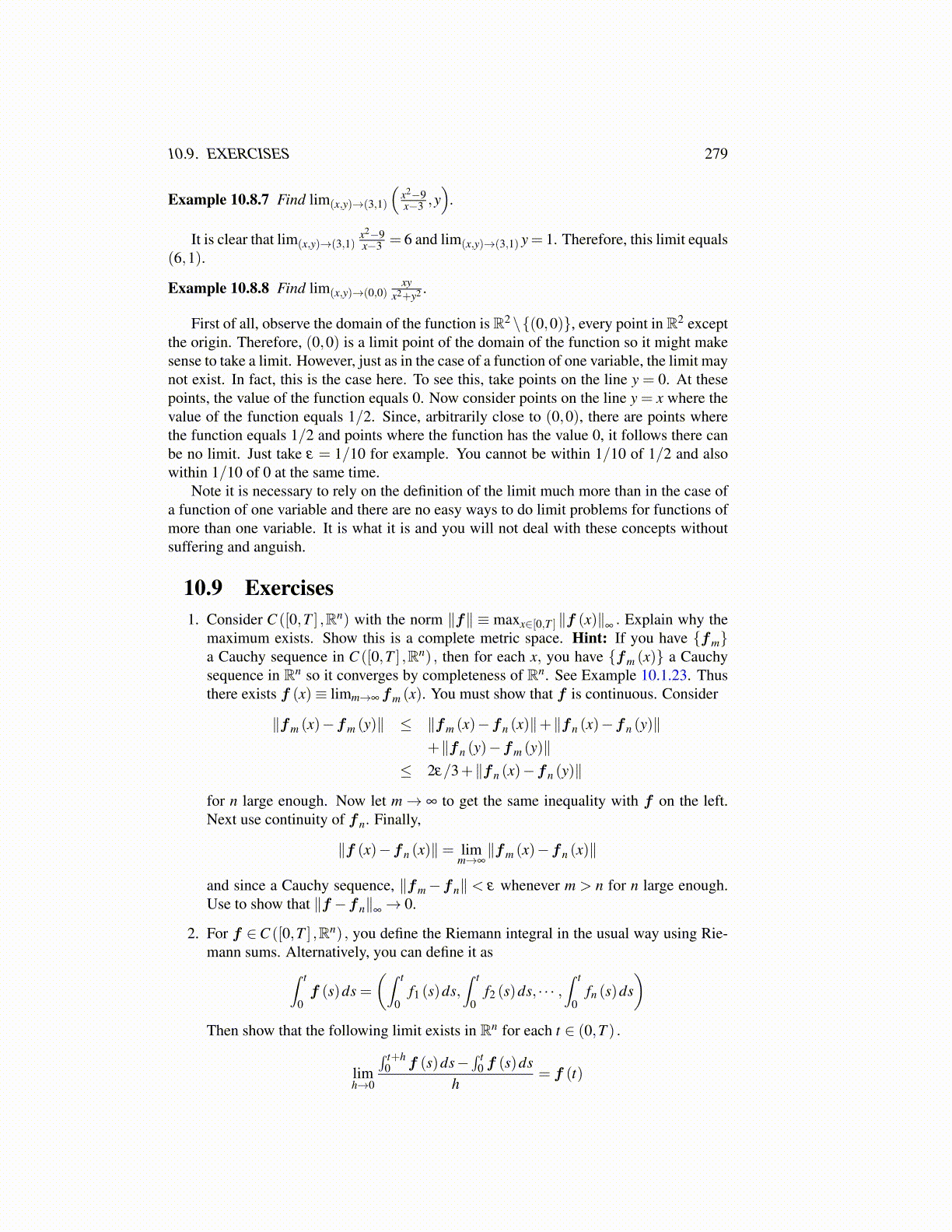
10.9. EXERCISES 279
Example 10.8.7 Find lim(x,y)→(3,1)
(x2−9x−3 ,y
).
It is clear that lim(x,y)→(3,1)x2−9x−3 = 6 and lim(x,y)→(3,1) y= 1. Therefore, this limit equals
(6,1).
Example 10.8.8 Find lim(x,y)→(0,0)xy
x2+y2 .
First of all, observe the domain of the function is R2 \{(0,0)}, every point in R2 exceptthe origin. Therefore, (0,0) is a limit point of the domain of the function so it might makesense to take a limit. However, just as in the case of a function of one variable, the limit maynot exist. In fact, this is the case here. To see this, take points on the line y = 0. At thesepoints, the value of the function equals 0. Now consider points on the line y = x where thevalue of the function equals 1/2. Since, arbitrarily close to (0,0), there are points wherethe function equals 1/2 and points where the function has the value 0, it follows there canbe no limit. Just take ε = 1/10 for example. You cannot be within 1/10 of 1/2 and alsowithin 1/10 of 0 at the same time.
Note it is necessary to rely on the definition of the limit much more than in the case ofa function of one variable and there are no easy ways to do limit problems for functions ofmore than one variable. It is what it is and you will not deal with these concepts withoutsuffering and anguish.
10.9 Exercises1. Consider C ([0,T ] ,Rn) with the norm ∥f∥ ≡ maxx∈[0,T ] ∥f (x)∥
∞. Explain why the
maximum exists. Show this is a complete metric space. Hint: If you have {fm}a Cauchy sequence in C ([0,T ] ,Rn) , then for each x, you have {fm (x)} a Cauchysequence in Rn so it converges by completeness of Rn. See Example 10.1.23. Thusthere exists f (x)≡ limm→∞fm (x). You must show that f is continuous. Consider
∥fm (x)−fm (y)∥ ≤ ∥fm (x)−fn (x)∥+∥fn (x)−fn (y)∥+∥fn (y)−fm (y)∥
≤ 2ε/3+∥fn (x)−fn (y)∥
for n large enough. Now let m→ ∞ to get the same inequality with f on the left.Next use continuity of fn. Finally,
∥f (x)−fn (x)∥= limm→∞∥fm (x)−fn (x)∥
and since a Cauchy sequence, ∥fm−fn∥ < ε whenever m > n for n large enough.Use to show that ∥f −fn∥∞
→ 0.
2. For f ∈C ([0,T ] ,Rn) , you define the Riemann integral in the usual way using Rie-mann sums. Alternatively, you can define it as∫ t
0f (s)ds =
(∫ t
0f1 (s)ds,
∫ t
0f2 (s)ds, · · · ,
∫ t
0fn (s)ds
)Then show that the following limit exists in Rn for each t ∈ (0,T ) .
limh→0
∫ t+h0 f (s)ds−
∫ t0 f (s)ds
h= f (t)